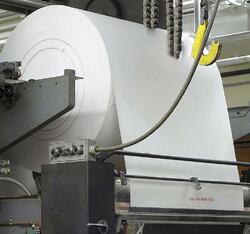 To be successful in production mail, an operation needs quality in three areas—people, equipment and materials. Quality people who are aware of industry guidelines and USPS regulations. Quality equipment that ensures high integrity at high speeds. And quality materials that conform to industry specifications and USPS publications.
To be successful in production mail, an operation needs quality in three areas—people, equipment and materials. Quality people who are aware of industry guidelines and USPS regulations. Quality equipment that ensures high integrity at high speeds. And quality materials that conform to industry specifications and USPS publications.To ensure that your materials meet industry specifications, you'll need to test certain characteristics. Some testing is easy, and can be performed in your shop. However, some of the testing requires sophisticated equipment, and should be performed by an external provider. Potential sources include your paper supplier, your printer manufacturer, and your inserter vendor.
The precise definitions and measurements for some of these characteristics are quite technical. You may have worked in the print and mail industry for years, unaware of these technical terms. However, as a true professional, you should learn more about this essential topic.
7 characteristics of paper
There are 7 characteristics of your paper and forms that will have a direct impact on the efficiency of your equipment:
1. Grain direction
2. Paper curl
3. Paper weight
4. Moisture content
5. Stiffness
6. Porosity
7. Perforation strength
1. Grain direction.
Refers to the direction of the paper fibers in relation to the sheet. "Cross grain" means the fibers run the width of the sheet. "Long grain" means the fibers run the length of the sheet. The most important aspect of grain direction is that it should always be oriented in the same direction as the paper flow on your equipment.
2. Paper curl.
How the paper edges curl toward or away from the printed image. Curl exists with all paper due to the manufacturing process, and while unavoidable, should be minimal. Curl is measured by the difference of the position of the center of the sheet when compared to the position of the edges. The range for acceptable edge curl is 0-20 mm. Any curl greater than this range is unacceptable, and will cause equipment jams.
3. Paper weight.
A measurement most people are familiar with. Paper weight is determined by how much a 500-sheet ream of 17x22 paper weighs. Most printer and inserter vendors recommend using 20 lb. or 24 lb. paper, and accept ranges between 18 lb. and 30 lb. paper. When paper is too light, it curls and bends excessively at high speeds. When paper is too heavy, it's not flexible enough to be manipulated by the equipment.
(Note: Paper and equipment manufacturers are moving to metric measurements for paper weight. The new standard is "gsm", or grams per square meter. For comparison purposes, 20 lb. paper stock is equivalent to 750 gsm stock.)
4. Moisture content.
Exactly what it sounds like. How much moisture is in your paper. High moisture content causes a reduction in paper stiffness and an increase in paper curl. Very low moisture content also causes paper curl, as well as static electricity. A paper moisture meter costs less than $250, and is a worthwhile investment. For best results, moisture content should range between 4 and 6 percent.
5. Stiffness.
Determined by the amount of pressure required to bend the paper. The measurement used is known as a Gurley unit, named after W.E. and L.E. Gurley, two brothers who were engineering alumni of Rensselaer Polytechnic Institute in the 1800s. Testing for Gurley units is a sophisticated process that you should request from your vendors. For long grain, 20 lb. paper, stiffness should be between 175-200 Gurley units, and for cross grain paper, 80-100 Gurley units.
6. Porosity.
Porosity is calculated by another Gurley measurement: Gurley seconds, the amount of time it takes 100cc of air to permeate 1 square inch of paper. Too much porosity causes moisture to be absorbed too quickly. Too little porosity doesn't allow enough moisture to be absorbed. In both cases, the end result is paper curl. For optimum results, porosity levels should be between 20 and 25 Gurley seconds. (Though ownership has changed, the Gurley brothers' company is still in business as Gurley Precision Instruments. Mention that bit of trivia at your next party, and amaze your friends!)
7. Perforation strength.
The last characteristic, perforation strength, is especially important for remittance and check mailers, as well as those who burst and trim continuous forms. Strength is measured by the amount of force needed to break the perforation. Internal perforations (remittance stubs and checks) should have a strength of at least 10 lb. per linear inch. Page perforations should have a strength of about 7 lb. per square inch.
Next: Paper Storage and Handling
